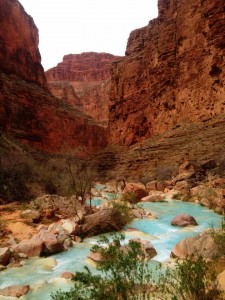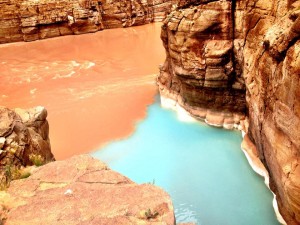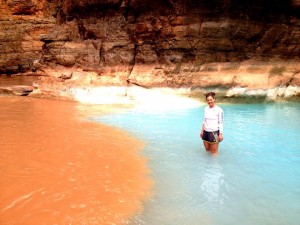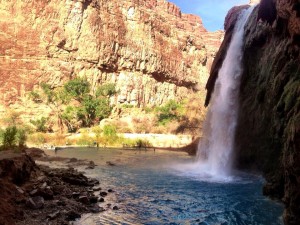If you come from an icy place, if the winter was long, or if your eyes have seen a wash of gray for months, a perfect escape is waiting for you in the Grand Canyon backcountry. What can I say about the American Southwest in the springtime? After hibernating all winter, certainly nothing in my lexicon can accurately describe the invigorating revival of human spirit; when new desert heat flows up your legs, a hot sun beams UVs through a blue sky, thawed insects hum, and the sweet smell of desert plants intoxicates.
 Now mix these attributes with moving water, a lush surrounding riparian zone canopied by towering Cottonwoods, and waterfalls… big ones. This is what is waiting for you at Havasupai. If you have heard this name before, chances are you also heard the water here is turquoise. Suspended lime in the water turns it a murky blue milk-water. In fact, the first white men who floated the Grand Canyon witnessed the confluence of the chocolaty Colorado and the blue milk-water of Havasu Canyon, and named it Shangri La. They were right.
Now mix these attributes with moving water, a lush surrounding riparian zone canopied by towering Cottonwoods, and waterfalls… big ones. This is what is waiting for you at Havasupai. If you have heard this name before, chances are you also heard the water here is turquoise. Suspended lime in the water turns it a murky blue milk-water. In fact, the first white men who floated the Grand Canyon witnessed the confluence of the chocolaty Colorado and the blue milk-water of Havasu Canyon, and named it Shangri La. They were right.
The iconic Route 66 will lead you to Hualapai Hilltop Rd. in Northwest Arizona. This road extends 60 miles to the rim of the Grand Canyon, though not within National Park boundaries. Being 20 miles from the Colorado River you will only see the opposite wall of a single canyon and a majorly wide canyon washbasin. This canyon is but a finger of the Grand, but still reaches far, wide, and deep.
This hike manages to reach backcountry, however Havasupai is a popular destination so expect to see other travelers and mule trains delivering supplies pass by every so often, on their way to or from a very isolated Indian village 10 miles down the trail, called Supai. The trailhead begins by switchback, down the canyon wall. As you slowly descend, a real feeling of how large this canyon is becomes realized, and this is a comparably small canyon to the Grand’s standards. When the trail leaves the cliff, we are led to the middle of the flats which offers a glimpse down the canyon, into the depths of the Grand where you we would be going.
 The trail leads across a plane and into a wash. Red walls rise out of the ground around you forming the slot canyon. So humble the walls seem now compared to ten miles down trail, where they will loom high and above as secondary and even tertiary cliff steps within the Grand’s striated mineral layers. Enjoy the geology!
The trail leads across a plane and into a wash. Red walls rise out of the ground around you forming the slot canyon. So humble the walls seem now compared to ten miles down trail, where they will loom high and above as secondary and even tertiary cliff steps within the Grand’s striated mineral layers. Enjoy the geology!
Six miles through, our slot canyon opens up to join Havasu Canyon. Greenery and flowing water are a welcome site. Truly we have come to an oasis. After some bridge crossings over the not-so-blue-yet waters, the canyon walls curve away to open a space for the village of Supai. Follow the path and signs through this unique place. Stop at the visitors’ center to pay for your campsite reservation. You can even stop at the general store and buy a slushy.
The next two miles take you away from town and offer views of several cascades, Navajo falls, and a big one, Havasu. Continue onward to find the campground, stopping to take a few pictures of the falls. I suggest finding a good campsite and leaving your backpacks there. This will save your spot from later arrivals and you will be very tired as it has been over 10 miles of hiking to this point. With packs off you can walk faster and lighter as you search for a better camp location. Some of the best campsites are in the middle or farthest points of the campground.
 If you take the time to get out here, stay to allow for at least two full days to explore. One day you can spend heading back into town (especially if you missed the reservation office hours hiking in), get a cold drink, then head back the way you came. Instead of going back to camp though, eat your day’s lunch at Navajo Falls. This aquamarine pool is deep enough to jump in from the falls above. A sign urges you not to jump; yet that stops seemingly no one. It’s 30-foot drop. The way back to camp passes Havasu Falls. I’d say you should go check it out, but they will compel your attention anyways… so plan to spend an hour or two there. Stand by the waterfall and feel the wind and mist. It is incredible. Sunbathe, swim, and hang out. On the way back to camp you can prod along the spring that runs through the campground, catching frogs. We called it “frog-prod.”
If you take the time to get out here, stay to allow for at least two full days to explore. One day you can spend heading back into town (especially if you missed the reservation office hours hiking in), get a cold drink, then head back the way you came. Instead of going back to camp though, eat your day’s lunch at Navajo Falls. This aquamarine pool is deep enough to jump in from the falls above. A sign urges you not to jump; yet that stops seemingly no one. It’s 30-foot drop. The way back to camp passes Havasu Falls. I’d say you should go check it out, but they will compel your attention anyways… so plan to spend an hour or two there. Stand by the waterfall and feel the wind and mist. It is incredible. Sunbathe, swim, and hang out. On the way back to camp you can prod along the spring that runs through the campground, catching frogs. We called it “frog-prod.”
For day two, go downstream to the Colorado River. It is eight miles there and eight back, so get an early start. Suggested leaving time is 9 am at the latest. This will get you back to camp around 6 to 7 pm so take a lunch. The climb down and into the cliffs that form Mooney Falls is quite the experience. Mooney dwarfs Havasu so the height is intimidating, but the view is spectacular. The climb has ladders and chains, just be careful. The next eight miles have dozens of river crossings and some ladder climbing. Reaching the Colorado is an accomplishment and the sight of America’s most powerful river is well worth the hike. Climb down the rocks to snap a few pics of the confluence. The two waters meeting is clearly awesome. Swimming up Havasu is a fun option too. You can only get about 100 yards before meeting an obstacle, but since you made it this far… hop in!
 The next day you can hike out, or spend another day loping around, recovering from all the activity of the previous days. If you want to add another adventure aspect to this trip try hiking in or out at night. Leaving around 9:30 pm, we hiked in with an almost-full moon and headlamps were hardly needed. The desert is a fine thing under the moon and stars. The canyon landscape drenched in silver is something I will never forget.
The next day you can hike out, or spend another day loping around, recovering from all the activity of the previous days. If you want to add another adventure aspect to this trip try hiking in or out at night. Leaving around 9:30 pm, we hiked in with an almost-full moon and headlamps were hardly needed. The desert is a fine thing under the moon and stars. The canyon landscape drenched in silver is something I will never forget.
Side Note: Be sure to call the Havasupai tribe’s campground reservation phone line. Information Online. Reservations are REQUIRED and the cost is slightly steep for hiking, but then again, there is nothing like Havasupai in the world!
SUGGESTED GEAR
There are 20 or so miles to the Colorado River and 20 back. I spent 3 nights there. Here is what I used:
Shoe: Keen Arroyo. As I have already reviewed on this website, these shoes show up and deliver! I only wore the Arroyo for ALL of Havasupai’s activities. The shoes have a sturdy sole for all that walking, grip on underwater rocks, drain completely, and feel almost sandal like with their open concept. With a good set of low-cut wool socks these shoes do everything. I dig ‘em.
Socks: Wool or some mixture of wool provides great benefits for feet. Any brand that has a cushion and doesn’t let one part of your shoe touch your skin will work great.
 Leggings: I brought no pants and we went in mid March. I did bring some long johns for sleeping and chilly mornings. Quick dry shorts work best.
Leggings: I brought no pants and we went in mid March. I did bring some long johns for sleeping and chilly mornings. Quick dry shorts work best.
Upper Body: I wore a T-shirt most times. I hike wearing shirts made from athletic material with a backpack. For day hikes I wore cotton T’s. For warmth at night and mornings bring a long underwear base layer. UnderArmor has great products for this. I also brought a North Face pullover to use for warmth and a pillow.
Miscellaneous: A bandana can do many things. Bring a stove because no fires are allowed in the canyon. I use a Jetboil; the thing works great wonders. Daypack- you’ll need to pack water and lunch for these hikes. CAMERA!
